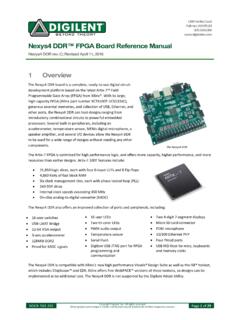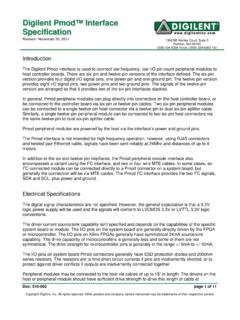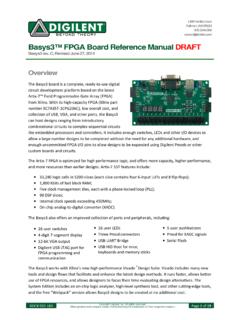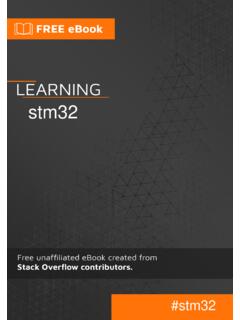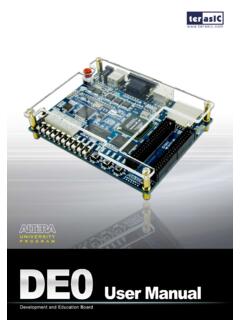Transcription of Basys 3™ FPGA Board Reference Manual - Digilent Reference
1 1300 Henley Court Pullman, WA 99163 Basys 3 FPGA Board Reference Manual Revised April 8, 2016 This Manual applies to the Basys 3 rev. C DOC#: 502-183 Copyright Digilent , Inc. All rights reserved. Other product and company names mentioned may be trademarks of their respective owners. Page 1 of 19 Overview The Basys 3 Board is a complete, ready-to-use digital circuit development platform based on the latest Artix -7 Field Programmable Gate Array (FPGA) from Xilinx . With its high-capacity FPGA (Xilinx part number XC7A35T-1 CPG236C), low overall cost, and collection of USB, VGA, and other ports, the Basys 3 can host designs ranging from introductory combinational circuits to complex sequential circuits like embedded processors and controllers.
2 It includes enough switches, LEDs, and other I/O devices to allow a large number of designs to be completed without the need for any additional hardware, and enough uncommitted FPGA I/O pins to allow designs to be expanded using Digilent Pmods or other custom boards and circuits. The Artix-7 FPGA is optimized for high performance logic, and offers more capacity, higher performance, and more resources than earlier designs. Artix-7 35T features include: The Basys 3 also offers an improved collection of ports and peripherals, including: 16 user switches 16 user LEDs 5 user pushbuttons 4-digit 7-segment display Three Pmod ports Pmod for XADC signals 12-bit VGA output USB-UART Bridge Serial Flash Digilent USB- jtag port for FPGA programming and communication USB HID Host for mice, keyboards and memory sticks The Basys 3 works with Xilinx's new high-performance Vivado Design Suite.
3 Vivado includes many new tools and design flows that facilitate and enhance the latest design methods. It runs faster, allows better use of FPGA resources, and allows designers to focus their time evaluating design alternatives. The System Edition includes an on-chip logic analyzer, high-level synthesis tool, other cutting-edge tools, and the free WebPACK version allows Basys 3 designs to be created at no additional cost. The Basys 3. 33,280 logic cells in 5200 slices (each slice contains four 6-input LUTs and 8 flip-flops) 1,800 Kbits of fast block RAM Five clock management tiles, each with a phase-locked loop (PLL) 90 DSP slices Internal clock speeds exceeding 450 MHz On-chip analog-to-digital converter (XADC) Basys 3 FPGA Board Reference Manual Copyright Digilent , Inc.
4 All rights reserved. Other product and company names mentioned may be trademarks of their respective owners. Page 2 of 19 2152141334568711912210116 Figure 1. Basys 3 FPGA Board with callouts. Table 1. Basys 3 Callouts and component descriptions. A growing collection of Board support IP, Reference designs, and add-on boards are available on the Digilent website. See the Basys 3 page at for more information. 1 Power Supplies The Basys 3 Board can receive power from the Digilent USB- jtag port (J4) or from a 5V external power supply. Jumper JP3 (near the power switch) determines which source is used. All Basys 3 power supplies can be turned on and off by a single logic-level power switch (SW16).
5 A power-good LED (LD20), driven by the "power good" output of the LTC3633 supply, indicates that the supplies are turned on and operating normally. An overview of the Basys 3 power circuit is shown in Fig. 2. Callout Component Description Callout Component Description 1 Power good LED 9 FPGA configuration reset button 2 Pmod port(s) 10 Programming mode jumper 3 Analog signal Pmod port (XADC) 11 USB host connector 4 Four digit 7-segment display 12 VGA connector 5 Slide switches (16) 13 Shared UART/ jtag USB port 6 LEDs (16) 14 External power connector 7 Pushbuttons (5) 15 Power Switch 8 FPGA programming done LED 16 Power Select Jumper Basys 3 FPGA Board Reference Manual Copyright Digilent , Inc.
6 All rights reserved. Other product and company names mentioned may be trademarks of their respective owners. Page 3 of 19 : LTC3633IC11: LTC3621 ENPGOOD300 mAVIN+-ON/OFFType A USB Host Connector (J2)JP2J65V External SupplyMicro-USB Port (J4)Power Source SelectJP2 USBEXTERNALP ower OnLED (LD20)PowerSwitch (SW16) Figure 2. Basys 3 power circuit. The USB port can deliver enough power for the vast majority of designs. A few demanding applications, including any that drive multiple peripheral boards, might require more power than the USB port can provide. Also, some applications may need to run without being connected to a PC's USB port.
7 In these instances an external power supply or battery pack can be used. An external power supply can be used by plugging into the external power header (J6) and setting jumper JP2 to "EXT". The supply must deliver to and at least 1A of current ( , at least 5W of power). Many suitable supplies can be purchased through Digi-Key or other catalog vendors. An external battery pack can be used by connecting the battery's positive terminal to the "EXT" pin of J6 and the negative terminal to the "GND" pin of J6. The power provided to USB devices that are connected to Host connector J2 is not regulated. Therefore, it is necessary to limit the maximum voltage of an external battery pack to DC.
8 The minimum voltage of the battery pack depends on the application; if the USB Host function (J2) is used, at least needs to be provided. In other cases, the minimum voltage is Voltage regulator circuits from Linear Technology create the required , , and supplies from the main power input. Table 2 provides additional information (typical currents depend strongly on FPGA configuration and the values provided are typical of medium size/speed designs). Table 2. Basys 3 power supplies. Supply Circuits Device Current (max/typical) FPGA I/O, USB ports, Clocks, Flash, PMODs IC10: LTC3633 2 to FPGA Core IC10: LTC3633 2A/ to FPGA Auxiliary and Ram IC11: LTC3621 300mA/ to Basys 3 FPGA Board Reference Manual Copyright Digilent , Inc.
9 All rights reserved. Other product and company names mentioned may be trademarks of their respective owners. Page 4 of 19 2 FPGA Configuration After power-on, the Artix-7 FPGA must be configured (or programmed) before it can perform any functions. You can configure the FPGA in one of three ways: 1. A PC can use the Digilent USB- jtag circuitry (portJ4, labeled "PROG") to program the FPGA any time the power is on. 2. A file stored in the nonvolatile serial (SPI) flash device can be transferred to the FPGA using the SPI port. 3. A programming file can be transferred from a USB memory stick attached to the USB HID port. Figure 3 shows the different options available for configuring the FPGA.
10 An on- Board "mode" jumper (JP1) selects between the programming modes. M0M1 JTAGPortUSB ControllerSPI Quad mode Flash1x6 JTAGH eaderSPIPortMicro-AB USB Connector (J4)USB- jtag /UART PortArtix-7 DonePIC24 Type A USB Host Connector (J2)SerialProg. Port26-pin jtag Header (J5)ProgM2 Mode (JP1)Programming ModeJP1 SPI FlashJTAGUSB Figure 3. Basys 3 configuration options. The FPGA configuration data is stored in files called bitstreams that have the .bit file extension. The Vivado software from Xilinx can create bitstreams from VHDL, Verilog , or schematic-based source files. Bitstreams are stored in SRAM-based memory cells within the FPGA.
